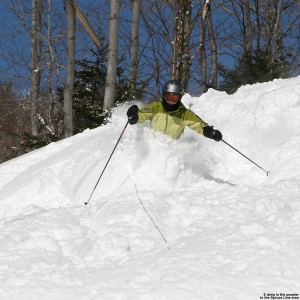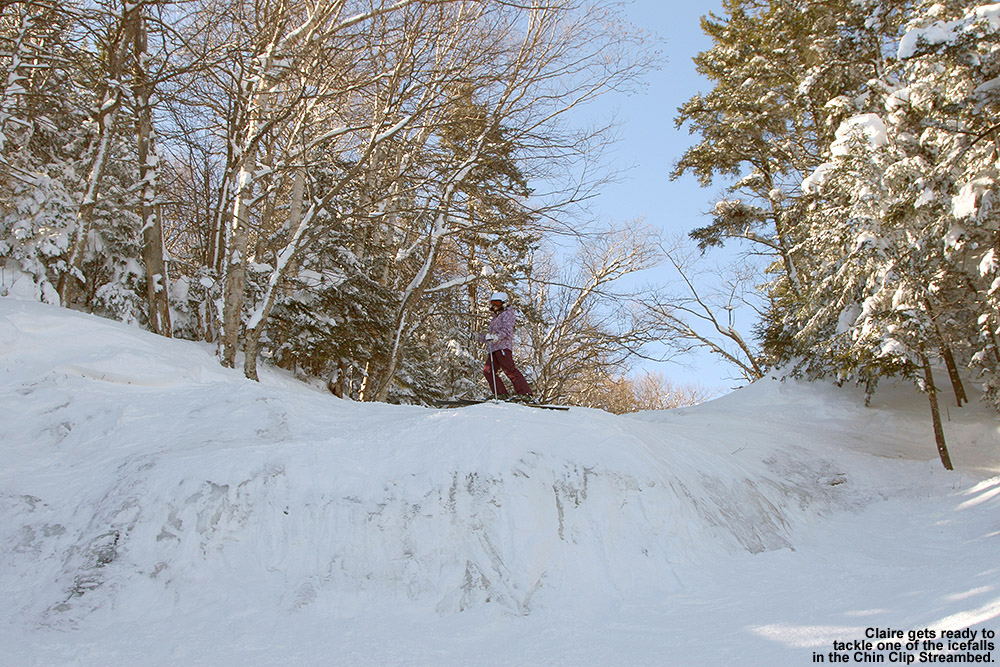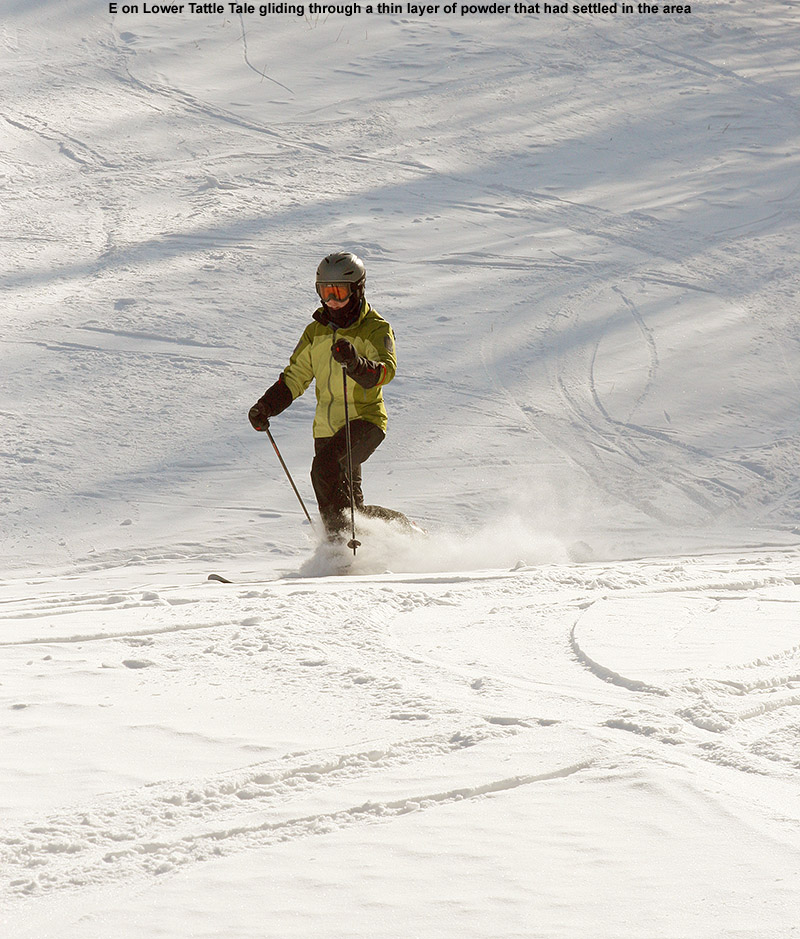
The local mountains have received multiple feet of snow over the past week or so, and the ski conditions have been mid-winter fantastic, but the continuous stretch of perfect snow looked like it might end in some areas yesterday as temperatures began to edge above freezing. I was at Bolton Valley yesterday, and we had a great morning of powder and packed powder conditions, but when the sun came out in the afternoon, temperatures shot up above freezing, and the powder began to get mushy. Temperatures dropped back down last night, which meant that any snow softening eventually stopped, but the question remained as to just how high the freezing levels had gone. There had been some concerns about rain overnight, but none of that seemed to materialize. We even had a touch of graupel/snow down at the house to sweeten up the surface of the snowpack, but what we really wanted to find out was what had gone on at Stowe, because that was our destination for today. Had it warmed up enough yesterday to affect the snow surfaces, and how much new snow had fallen on the mountain after that point? More snow was actually in the forecast for today, and that potential was encouraging, as it offered the chance to freshen up any surfaces that had deteriorated with the temperature changes. There were plenty of possible outcomes for today’s ski surfaces, but our questions wouldn’t really be answered until we actually got on the snow in the afternoon. Fortunately, the snow that was in the forecast had already materialized, and Mt. Mansfield was busy catching its share.
When we finally headed off to Stowe in the late morning, we found that snow was falling lightly in the mountain valleys to the east of the Greens. Meanwhile, off to the west, the mountains themselves were hidden behind a veil of more intense snowfall. As we approached Mt. Mansfield the snowfall grew steadier and heavier, and while it would still be considered light in intensity, it was accumulating even at the base elevations (~1,500’) when we arrived at the resort. As is often the case, the snowfall was heaviest over by The Chin, so we knew that there would be some decent accumulations up there.
It was pretty much the usual Sunday routine at the resort today, although the number of visitors was definitely on the low side. We had our standard coaching group, with me, Ty, Dylan, Luke and Jack. Claire was likely to be with us as well, but she had to make sure that all the groups were set for coaches, so the rest of us did a warm up run while she took care of coordinator duties. We made a trip up the Sunny Spruce Quad, and up top at around 2,500’ we found new snow accumulations of roughly two inches. The warming from yesterday had indeed hit Spruce Peak up to that elevation though, as there was a melt/sun crust below the new snow that made the off piste skiing not nearly as blissful as what it had been last week. With that said, it wasn’t a massive warm up, so our forays into the trees in the Side Street area revealed some decent turns, but you really had to be on your game due to the variability of the subsurface.
While not fantastic, the off piste conditions on the lower slopes of Spruce were encouraging enough to make me suspect that with both higher elevations and a much better aspect, the snow on Mt. Mansfield could be really good. So, as soon as Claire found out that all the program groups were set, we met up and were immediately on the Over Easy to the big mountain. Last Sunday we’d brought the boys to the Chin Clip Streambed for the first time, and this new playground was met with resounding enthusiasm. To continue the trend of terrain introductions, I decided that it was time to get them out to the Kitchen Wall. Today was the perfect opportunity to do it as well, since if anywhere on the mountain had preserved winter snow, the Kitchen Wall would do it. As a test of snow conditions, for our first run we cut in below the Kitchen Wall traverse – I didn’t quite want to bring them all the way out on the full traverse if we were going to be dealing with some sort of nasty crust. There was no cause for concern though, the cooling power of Mt. Mansfield had been in full effect yesterday; thus there were no signs of crust and the powder was fantastic. We skied through the catacombs of trees that brought us back to Cliff Trail, and the snow was simply amazing, mid winter powder down to the 3,000’ elevation. We caught Rim Rock over to Switchback, and while not quite as stellar as it had been above the 3,000’ mark, the snow still stayed decent all the way down to ~2,500’. Below that elevation you could manage some OK turns off piste, but the returns on your effort were minimal, so on piste was the way to go. Grooming and/or skier traffic took care of any subsurface issues, so turns were beautiful if you stayed on piste. Still, a half run with off piste options topped off with another 1,000’ of groomers made for quite a nice descent, so we immediately hit the gondola for another round.

This time, I brought Claire and the boys on the full Kitchen Wall traverse, and the ups and downs on the unknown route into what seemed like wilderness, brought plenty of excitement to the boys’ faces. As usual, we encountered lots of cool snow formations that had been brought about by almost a season’s worth of leeward snow accumulations from winter storms. When I felt that we’d traversed far enough, we stopped atop one of the snowfields, and let the boys play around in the snow and soak in the atmosphere. They had a great time, climbing on the rocks, poking their noses into caves, playing in the steep and deep faces of snow, and just being boys in winter. The snow quality was fantastic up there, and with layer after layer from the recent storms, it was indeed starting to get deep. Writing this report up now, as I look at the notes I made myself about the Kitchen Wall I see the words “bottomless, bottomless, bottomless”. I’d say that sums it up right there. Dropping steep turns through one of the Kitchen Wall snowfields was certainly a primo experience, but all down through the trees below, the snow was excellent. We eventually made our way along Cliff Trail, over to Nosedive, and then worked into the Goatdive woods to see just how low we could go with good snow off piste. We hung in there for a while before eventually merging back on piste at Goat, where the bumps were in mid winter form. When one starts a run at the Kitchen Wall, it can seem like the run goes on forever, and this was one of those. When we finally reached the base of the Fourrunner Quad, it felt like ages had gone by since the boys were floundering around in the deep powder way up below the Mansfield ridgeline.

Powderfreak recently posted a picture from a run on Stowe’s Lookout trail in the New England Regional Forum at American Weather, and it got me thinking about what a great trail it is, so I brought it up as a descent option and the boys were game. I’m not sure how long it’s been since we’ve taken a run down Lookout, but I’m continually impressed with just how steep and long it is. We got treated to some great snow surfaces, and the sight of big beautiful flakes falling from the sky as Mother Nature continued to beef up the cushioning of the surfaces for us. The boys still hadn’t had enough after that run though, so from back at the Gondola we skied the Tombo Waterfall down to Perry Merrill. Ty led an amazing charge down Perry Merrill, with relentless slalom turns along the skier’s right of the trail. It was all I could do to keep up with his pace, and anyone that hung with us got quite a workout. If I’d been on my Telemark skis there was no way I would have been able to keep that pace for that long, so thank heavens for alpines.

So although there was some 32+ warming below the 2,500’ level on Mt. Mansfield yesterday, the conditions really were quite impressive over much of the mountain today. Although not intense, it snowed all afternoon, and that really helped to keep improving those surfaces that needed it. There had to be a few inches of new accumulation up above 3,000’, and since it doesn’t seem like those areas ever went above freezing anyway, they’re just going to be getting better. Basically everything on the upper half of the mountain was very much like it’s been all week, deep and soft like you’d expect to find in Northern Vermont in March. Some of the heaviest snowfall we saw today was actually when we were leaving, and it was still snowing in the valleys most of the way home. The snow gradually dropped off in intensity as we headed toward Stowe Village, and was fairly minimal through Waterbury Center and Colbyville, but as we headed down the hill from Colbyville into Waterbury, it began to pick up and I suspected it was even more intense at the house. We looked down the Winooski Valley and saw that indeed there was an impressive wall of white in that direction. By this evening, we’d picked up another couple of inches of snow at the house, which should translate into at least that much in the mountains. Conditions are very good, so get out and get those turns.







































































































































